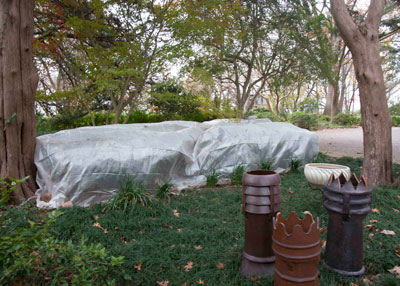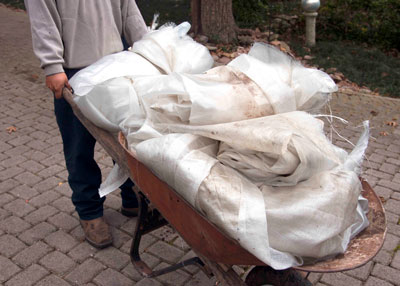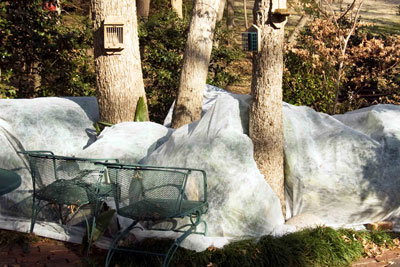Covering Tender Plants
Most of Texas had an encounter with cold earlier this week, and it served to alert us that winter is at the doorstep. Don’t get caught with your plants down. Get your supplies ready now. It’s really quite simple.
Which plants need to be covered?
• Frost-sensitive flowers and vegetables to protect them from the first frost of fall (You may be a bit late on that one!) or the last frost of spring.
• Winter color plants that have vigorous new growth and blooms if temperatures are going to be extremely cold.
• Shrubs that are near the north ends of their Hardiness Zones when record low temperatures are expected.

My wife and I live on the cold north side of DFW. I should never have planted 250 cast iron plants (aspidistra), but I did. Hardly a winter goes by without our having to put frost cloth over them. Without it I’d have to cut them back to the ground every spring.
What types of covers work best?
• Lightweight frost cloths have been manufactured specifically for this purpose. They’ve made a name for themselves in commercial vegetable and strawberry production.

Some brands of frost cloth are very sheer. Surprisingly, they still provide very good protection from cold.
• Old sheets and burlap can work, although not as well as the frost cloths.
• Sheet plastic films do create a greenhouse-like environment, but if they come into contact with plant leaves it’s very likely that those leaves will be burned. Plastics also trap the sun’s rays and heat up too rapidly on sunny mornings following low temperatures. They also weight down from snow and ice in northern parts of the state. In short, they’re not usually advisable.
How do frost cloths work?
• They slow the rate of freezing and thawing. Rapid temperature changes are very damaging to plants.
• They allow the sun’s radiant energy to reach the soil, then they hold it beneath the covers. They can make a difference of 6 to 8 degrees in the temperature around your plants.
How and when do you put frost cloths in place?
• Buy a roll of wide fabric (8- or 10-ft.). Cut it to fit each bed you will be covering. Carefully fold it and put it into large plastic trash bags. Label them conspicuously so they won’t get mixed in with the trash. Set them aside until you need them.

Frost cloth has been cut to fit. Actually, these pieces have been used in a prior winter but they’re still fine to use again.
• When you hear that extreme cold is coming, water your beds thoroughly, then pull the frost cloth over your plants. Weight them down with bricks or river rocks so that they make continuous contact with the soil. If there are joints where two pieces come together secure them with clips.
How long can frost cloth be left in place?
• For a fairly small bed you’ll probably want to remove the frost cloth once temperatures have moderated. Fold it back up and put it back into its bag for repeated use.
• For large beds that are difficult to cover you can leave frost cloth in place for many weeks. I have two large beds of cast iron plant that have been covered from mid-December into the first week of March. I do push water hoses in beneath the frost cloth, but otherwise I just leave the beds alone.

These shrubs and cast iron plants remained covered for 10 weeks and were still green and fresh when uncovered in early spring.
